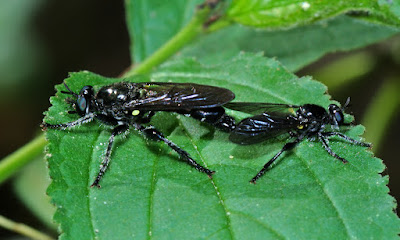"Total empirical adequacy could itself be read in a small, human way, or in a larger way in which the brakes on human awareness are taken off. Thus a theory might be empirically adequate only because we do not look in the right place: constraints of time or space may prevent us from making observations that show that the theory is not, in the wider sense, adequate to the phenomena. This is the contrast between ‘empirically adequate as far as we can tell’ and ‘empirically adequate as far as ideal investigation could tell it, or as far as it could ever be told’. Total empirical adequacy means only the latter."
— Simon Blackburn
I spent the weekend under gorgeous blue skies exploring several of my favorite summer insect haunts. My mission was to observe and photograph a few particular target species: Sandy Stream Tiger Beetle, Northern Barrens Tiger Beetle, and Gnat Ogre. But I'm not necessarily choosey ― I'll photograph just about any macro-able critter I happen upon. First stop, Sauk City Canoe Launch along the Wisconsin River. The morning was cool and crisp. With two cups of coffee down the hatch, I was ready.
Numerous Bronzed Tiger Beetles were already active. Soon I found Festive, a single Punctured, then a few Big Sand Tiger Beetles. With each step, my anticipation grew, my eyes scanning every inch of the shoreline. As minutes turned into an hour, my enthusiasm started to wane. A notion crept into my mind that weren't any Sandy Stream Tiger Beetles. Then two hours slipped by and doubt continued to tug at the edges of my mind, contemplating whether my quest would end in success. But just as I was about to succumb to uncertainty, there it was ― a flash of metallic copper and tan amidst the wettest part of the shoreline.
But there was only this one individual ... surprising! Not that anyone is keeping score, but this was species 10 for 2023. There's less emphasis on trying to see all 16 species in a single season, as I didn't bother going north for Cow Path or Boreal Long-lipped this year. It's likely I'll get Virginia Metallic and Claybank yet, which would put my tally in the camp of typical tiger beetle season for me, 12 to 14.
And there was only a single Shoreline Wolf Spider ...
Given the larger beach area and receding shoreline caused by the drought, there were quite a few Big Sand Tiger Beetles patrolling the dry sand ...
And Bronzed ...
I wonder if they'll be around in early November like last year?
Here's a Robber Fly Proctacanthella cacopiliga with prey ...
Other beach users began to arrive, but I was ready to wrap it up. Target species found, there was still plenty of time left in the day to explore elsewhere.
Back to Middleton and Pheasant Branch Prairie and Savanna ...
Shockingly, not very many insects were present. I did find a few Buffalo Treehoppers on Cupplant Silphium perfoliatum, which is a favorite host plant for these tiny insects.
If you look closely, you can see the hopper's proboscis jabbed into the plant's phloem to extract nutriment. It's a sap which is under pressure and puncturing it results in a constant stream the insect has to deal with. To do so, they regularly discharge the sap so they don't explode, filtering out the nutrients they need. The waste, so to speak, is a form of surgery exudate or honeydew, which is sometimes consumed by attending ants or other insects.
And another Two-horned Treehopper ...
Gnat Ogres! Target species number two.
As longtime readers know, these are actually robber flies in the genus Holcocephala. They're easily missed, but search the tips of tall plants or vertical sticks (often dead plants) near a source of water. Here they patiently wait for tiny flies to zoom past.
Occasoinally flying sorties, but coming back empty ...
And then ...
Gotcha!
In nature's realm, where wonders fly,
There dwells a creature, feared and sly.
A predator of the air, with stealth it roams,
A nimble hunter, claiming buzzing homes.
The gnat ogre feeds upon its catch,
A ballet of brutality, nature's perfect match.
No sympathy or remorse, just the cycle of life,
The hunter and hunted, engaged in endless strife.
Note the tan color on this individual. This one might be Holcocephala abdominalis, but nailing the identification down to species can be a tricky endeavor in this genus.
Male and female Laphria canis in congress — an excellent find.
Again, perhaps the drought is to blame, but it does seem like this season is necessitating much more effort to locate target and favorite insect species.
I did make a trip to Spring Green Preserve's West Unit, but I didn't find any Northern Barrens Tiger Beetles. The anniversary from last year's discovery is still a couple of weeks away, but perhaps those particular beetles were merely seasonally displaced. Time will tell. The only tiger beetles present were a few Punctured and a single Six-spotted. Noteworthy was a Blue Grosbeak singing from east of the trail in the oaks. I may have been too late this summer, but I didn't find any Prairie Fame Flowers.
Nature awakens with vibrant energy and breathtaking displays during July. The sun casts its golden rays upon the land, igniting a symphony of colors and scents. Lush green meadows sway under the warm breeze, adorned with an array of wildflowers in bloom. Trees provide shelter and shade, their canopies teeming with avian songsters. Rivers and streams glisten under the sunlight, inviting creatures of all kinds to quench their thirst and cool their bodies. From woods to tranquil shorelines, nature in July paints a picturesque scene of abundance and vitality, reminding us of the beauty and harmony that thrives in this season of abundance.
All images © 2023 Mike McDowell





























